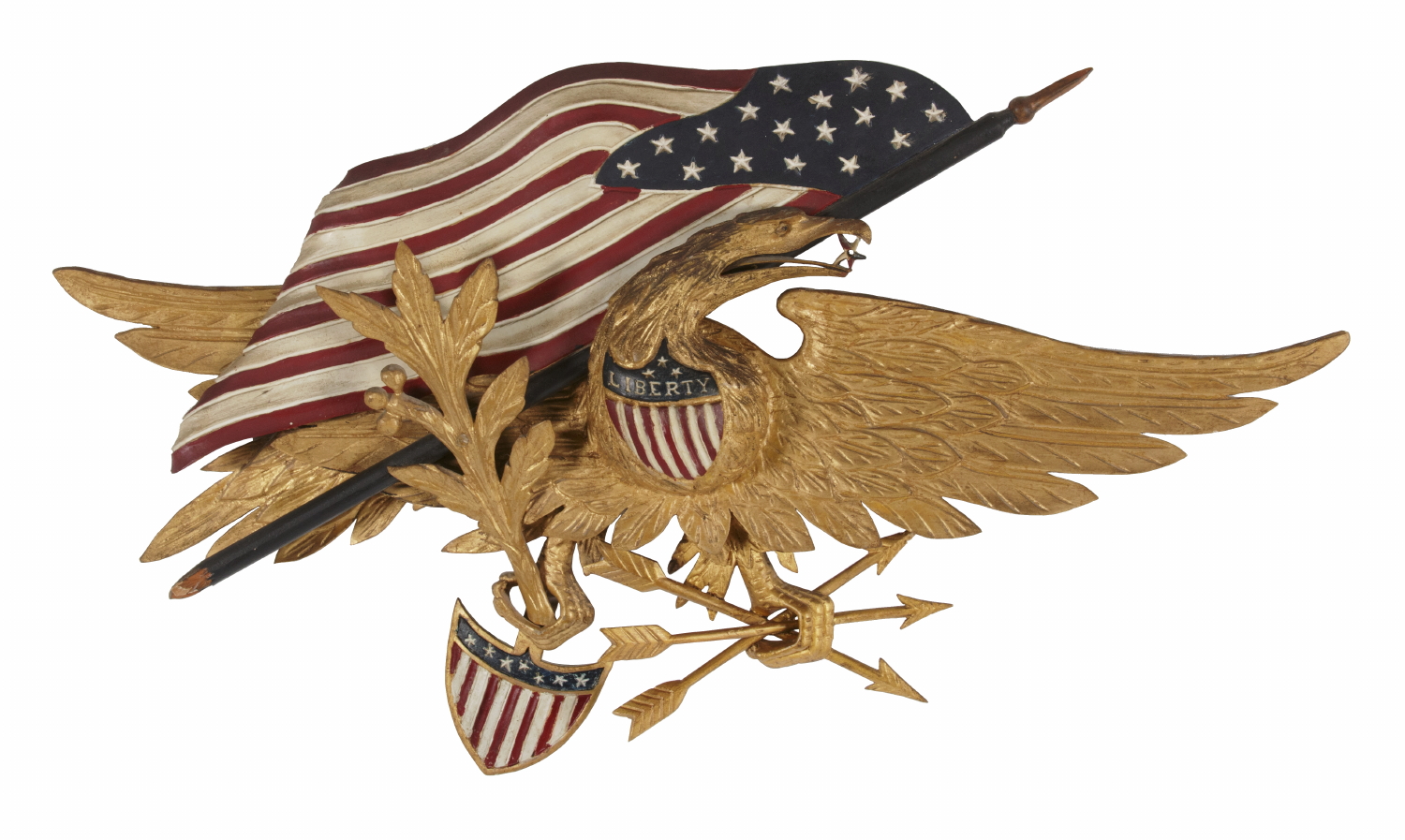
| |
CARVED EAGLE BY GEORGE STAPF, HARRISBURG, PENNSYLVANIA, AN UNUSUALLY FINE EXAMPLE WITH A STAR IN ITS BEAK AND A SHIELD IN RELIEF ON ITS BREAST WITH THE WORD "LIBERTY," FEATURES UNIQUE TO THIS CARVING, 1890-WWI |
| |
|
| Dimensions (inches): |
27.5" wide x 16" tall x 2.5" d |
| Description: |
|
Patriotic eagle attributed to Pennsylvania carver George Stapf (1862-1958) of Harrisburg, a carpenter who produced exuberantly stylized examples for Government buildings and G.A.R. (Civil War veteran’s) halls.
Born in Columbia, PA in 1862, on the banks of the Susquehanna River, Stapf was the son of a German engineer. At some point he moved to Lancaster City, where he made candy and opened a confectionery. He was successful in this venture and sold a caramel recipe to Milton Hershey. Around 1890 he left the candy business behind for some reason and moved to Harrisburg, where he and his brother, John, opened a carpentry business. They built houses and buildings and George had a specialty in spiral staircases. One that he built survives today in the Dauphin County Historical Society.
Working in a shop behind his home at 47 W. 14th Street, he began in the winter during the 1890's to carve eagles, in order to supplement his income in the winter months when the climate got in the way of construction. He stopped around WWI (U.S. involvement 1917-18). He made various sizes, primarily in two basic styles, almost all of which, among recorded examples, grip federal shields in their talons and wrap elongated necks around the staff of waving Stars & Stripes flags.
Until 20 years ago or so Stapf was unknown to the antiques world. Because of the somewhat dragon-like elements present in his designs, some formerly thought these were China Trade eagles. Only recently were they identified to this Pennsylvania German working in the region from which some of the best American folk art originated. Stapf's interpretation probably had less to do with oriental influence and more to do with a rural carpenter's personalized, folk style rendering of the typical snake-head or turkey-head eagles, seen throughout the American colonial and federal periods.
Huge examples, measuring between 6 and 8 feet in length, were purchased by the Commonwealth to decorate the Pennsylvania State Capital during its re-dedication in 1906, at which President Theodore Roosevelt was the keynote speaker.
This particular carving is unique among known examples and a masterpiece of Stapf's work. To date, this is the only Stapf eagle that has been discovered that features a carved, 5-pointed star with a pierced center, gently held it its outstretched beak. It also features a second shield, this one carved in relief upon the beast of the bird, with the word "liberty" emblazoned across the upper register beneath a triangle of 3 stars.
The olive branch is also different, greatly enlarged and directed toward 11:00, positioned between the eagle's right wing and the staff of the flag. This helps to cradle the flag at its canted, 45 degree angle. The arrows are more delicate and detailed than the dart-style ones favored by the carver. The finial of the flag staff is unusually fine, turned instead of carved to a simply tapered spear, and the opposite end is purposely carved and painted to appear broken, which is something I have not before seen. The neck of this eagle is more like that of Stapf's contemporary New England counterpart, John Haley Bellamy (1836-1914), in that it does not wrap around the flag, but is rather positioned in front of it, facing to the eagle's left.
The elongated head with its dramatic beak and tongue are signatures of Stapf's unique style and endeared by connoisseurs of American folk art. His carvings have great personality, are desirable in the collecting community, and are rarer than those of Bellamy in the marketplace. Among those that survive, this can be counted among the best.
Stapf passed in 1958 at the ripe old age of 96. The shop in which he carved no longer stands.
Provenance: Said to have hung in a family jewelry store for many years; ex-Allan Katz.
Condition: The back half of two of the arrows were restored and the surface was professionally cleaned by a previous owner. Two screws on the back were moved. |
|
|
| |
|
| Primary Color: |
gold, red, white, blue |
|
| Earliest Date: |
1890 |
|
| Latest Date: |
1918 |
|
| For Sale Status: |
Sold |
|
| Price |
SOLD |
|
| E-mail: |
info@jeffbridgman.com |
|
 |
|
Page Views:... 2031 |
|


